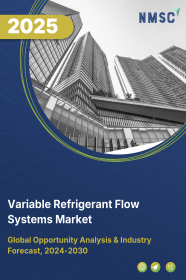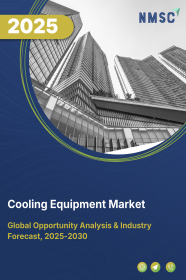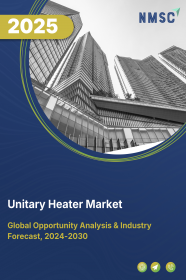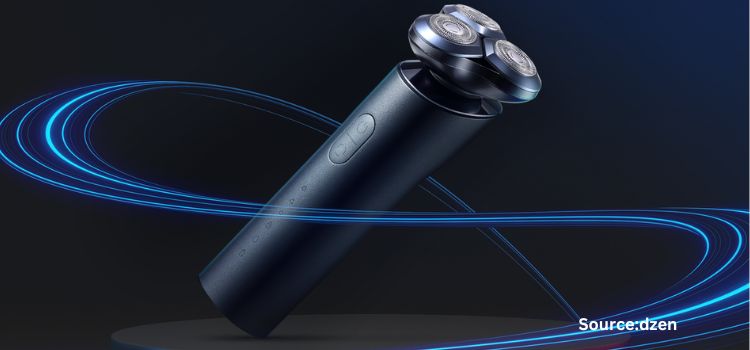
Variable Refrigerant Flow Systems Market by Component (Outdoor Units, Indoor Units, and Control system), by Type (Heat Pump System and Heat Recovery System), By Capacity (Upto 10 Tons, 11-18 Tons, 19-26 Tons, and Above 26 Tons), and by Application (Commercial, Residential, and Industrial)– Global Opportunity Analysis and Industry Forecast 2025-2030.
US Tariff Impact on Variable Refrigerant Flow Systems Market
Trump Tariffs Are Reshaping Global Business
Variable Refrigerant Flow Systems Market Overview
The Global Variable Refrigerant Flow Systems Market size was valued at USD 21.40 billion in 2024, and is expected to be valued at USD 23.58 billion by the end of 2025. The industry is projected to grow further, hitting USD 38.25 billion by 2030, with a CAGR of 10.2% between 2025 and 2030.
The variable refrigerant flow systems market is experiencing notable growth, driven by factors such as increasing awareness of energy efficiency, rapid urbanization accompanied by infrastructure development, and continuous technological advancements in HVAC solutions. These trends are supported by drivers including the rising emphasis on sustainable and energy-efficient systems, the expanding need for climate control in modern urban infrastructure, and the development of advanced VRF technologies that enhance energy management and system performance, all contributing to the market’s expanding footprint.
However, the market faces restraints, notably the high upfront costs associated with VRF system installation and equipment, which may limit adoption among cost-conscious consumers and small-scale projects. Despite this, opportunities for industry players are emerging through ongoing technological innovations that promise more efficient, intelligent, and adaptable VRF systems. These advancements are expected to open new avenues for application, particularly in residential sectors and smart building initiatives.
The Rising awareness for Energy Efficiency Fuels the Growth of the Market
The rising demand for energy-efficient solutions stands as a major factor for the variable refrigerant flow systems market growth. In a world increasingly conscious of environmental impact and rising energy costs, businesses and homeowners are actively seeking technologies that can minimize their carbon footprint and reduce operational expenses. VRF systems offer superior energy efficiency by precisely controlling the flow of refrigerant to different zones within a building based on individual heating and cooling demands. This significant energy-saving potential makes VRF systems an increasingly attractive option, driving their adoption across various applications.
Urbanization and Infrastructure Development Boosts the Growth of the Market
The rapid pace of urbanization and infrastructure development, particularly in growing economies, provides a substantial impetus for the expansion of the variable refrigerant flow systems market trends. As cities grow and new commercial and residential spaces emerge, the need for advanced HVAC systems capable of efficiently managing the climate control of large and complex structures intensifies. VRF systems are particularly well-suited for buildings with multiple zones and varied heating/cooling loads, such as hotels, schools, hospitals, and multi-storied residential buildings. The ability of VRF technology to offer individualized comfort control in numerous spaces from a single outdoor unit makes it a practical and efficient solution for modern urban developments.
Technological Advancement Further Boosts the Market
Continuous technological advancements in VRF technology are significantly contributing to the market's robust growth. Innovations such as smart controls, integration with building management systems (BMS), and enhanced refrigerant flow management are making VRF systems more efficient, user-friendly, and appealing to modern building owners and developers. The introduction of AI-powered features leverages spatial and situational learning to optimize operation and improve energy savings showcasing cutting-edge technology and attractiveness of VRF systems. Furthermore, ongoing developments in refrigerant technology are leading to more eco-friendly alternatives with reduced ozone depletion potential and improved efficiency. These technological leaps not only improve performance but also align with the growing focus on sustainability, further driving market adoption.
High Upfront Costs Hinder the Growth of the Market
A key challenge limiting the widespread adoption of VRF systems is their relatively high initial cost compared to conventional HVAC solutions. This includes the expenses associated with both the equipment and the installation process. While the long-term benefits of VRF systems, such as significant energy savings and potentially lower maintenance costs, can offset this initial investment, the upfront capital expenditure can be a deterrent for some potential customers, particularly in price-sensitive markets or for projects with tight budgets. Overcoming this challenge requires highlighting the life-cycle cost advantages and potentially exploring financing options or government incentives to mitigate the initial financial burden.
Integration of Smart Technologies and IoT Creates Ample Opportunities
The growing integration of Internet of Things (IoT) technologies and intelligent control systems into HVAC infrastructure is creating a major opportunity for the VRF systems market. Modern consumers and building operators increasingly demand systems that offer remote monitoring, predictive maintenance, and energy optimization—capabilities VRF systems are now being designed to support. With advancements in AI-driven climate control and cloud-based energy management platforms, VRF systems can now deliver real-time efficiency tracking and adaptive performance based on occupancy and external conditions. These smart features not only improve user comfort and energy savings but also align with the growing trend of smart buildings and connected infrastructure. As smart city initiatives and digitization in facility management continue to expand globally, VRF systems equipped with smart functionalities are positioned to see a significant rise in adoption across both commercial and residential segments.
Market Segmentation and Scope of the Study
The variable refrigerant flow systems market report is segmented on the basis of component, type, capacity, application and region. On the basis of component, the market is divided into outdoor units, indoor units, and control systems. On the basis of type, the market is divided into heat pump system and heat recovery system. On the basis of capacity, the market is divided into upto 10 tons, 11-18 tons, 19-26 tons, and above 26 tons. On the basis of application, the market is divided into commercial, residential, and industrial. Regional breakdown and analysis of each of the aforesaid segments include regions comprising North America, Europe, Asia-Pacific, and RoW.
Geographical Analysis
Asia-Pacific holds a dominant position in the global VRF systems market, influenced by rapid urbanization, regional climate diversity, and strong governmental emphasis on sustainable infrastructure. Countries like India are witnessing extensive infrastructure development, with smart city projects and green building policies playing a central role in driving demand for energy-efficient HVAC systems. In January 2024, Daikin introduced a new R-32-based VRF system tailored for high-rise buildings in India, reflecting regional needs and refrigerant compliance. Additionally, Japan and South Korea continue to lead in technological innovation, supporting regional growth through locally manufactured systems designed for high efficiency and flexible installation.
North America is showing rapid adoption of VRF systems, primarily driven by the increasing focus on energy efficiency and sustainability in building design. Government-backed initiatives to reduce carbon emissions and improve energy performance are prompting commercial and institutional sectors to transition from conventional HVAC systems to more flexible and efficient VRF technologies. The evolving refrigerant regulations, including the AIM Act in the U.S., are shaping product development as manufacturers shift toward low-GWP refrigerants in compliance with 2026 deadlines.
The European VRF market is shaped by strict environmental regulations and a strong emphasis on reducing energy consumption in buildings. Many European countries are adopting energy performance standards that favor the use of advanced HVAC solutions, including VRF systems. Recent developments include the introduction of water-cooled VRF units and heat recovery systems, particularly in Western Europe, to improve building efficiency under varied climatic conditions.
Regions such as the Middle East, Africa, and South America present emerging opportunities for VRF adoption, with growing construction activities and increased awareness of energy conservation. Governments across the Middle East are promoting sustainable building practices, and countries like the UAE and Saudi Arabia are incorporating energy-efficient systems into large-scale developments. In 2023, Rheem introduced its SAVR-D VRF range in the Middle East, highlighting a regional push toward indoor air quality and energy-efficient cooling. As infrastructure and urban development accelerate across these regions, the demand for scalable, efficient HVAC systems like VRF is expected to rise, supported by policy-driven growth and expanding commercial spaces.
Strategic Innovations and Specialized Solutions Drive Competitive Edge in the VRF System Market
Leading players in the global Variable Refrigerant Flow (VRF) system industry are strategically focusing on innovation and adapting to evolving market demands and regulations. For instance, Carrier Vietnam recently introduced its latest generation XCT7 VRF technology, emphasizing improved reliability, enhanced performance, high efficiency, and flexibility. Daikin, a major player and the originator of VRF technology, has strategically introduced its CO2 VRV range in Europe, showcasing a commitment to developing solutions with lower carbon footprints and anticipating refrigerant legislation. LG also launched its energy-efficient Multi V i VRF solution with an AI engine, initially targeting Europe, highlighting features like AI Smart Care for optimized energy savings based on occupancy and environmental conditions. These developments reflect a market trend towards greater energy efficiency and the use of more sustainable refrigerants. However, these key players face challenges such as the refrigerant shift driven by regulations like the AIM Act in the U.S., which requires a transition to low Global Warming Potential (GWP) refrigerants like A2L refrigerants (R-454B and R-32) by 2026. This shift necessitates changes in safety protocols and installation practices. Despite the higher initial cost of VRF systems compared to traditional HVAC, the increasing demand for energy-efficient solutions and the growth potential in emerging markets, particularly in the Asia-Pacific region, including India with its significant infrastructure development, present substantial opportunities for these manufacturers to expand their market share and overall market size.
KEY BENEFITS
-
The report provides quantitative analysis and estimations of the variable refrigerant flow systems market from 2025 to 2030, which assists in identifying the prevailing market opportunities.
-
The study comprises a deep dive analysis of the variable refrigerant flow systems market including the current and future trends to depict prevalent investment pockets in the market.
-
Information related to key drivers, restraints, and opportunities and their impact on the variable refrigerant flow systems market is provided in the report.
-
Competitive analysis of the players, along with their market share is provided in the report.
-
SWOT analysis and Porters Five Forces model is elaborated in the study.
-
Value chain analysis in the market study provides a clear picture of roles of stakeholders.
Variable Refrigerant Flow Systems Market Key Segments
By Component
-
Outdoor Units
-
Indoor Units
-
Control System
By Type
-
Heat Pump System
-
Heat Recovery System
By Capacity
-
Upto 10 Tons
-
11-18 Tons
-
19-26 Tons
-
Above 26 Tons
By Application
-
Commercial
-
Residential
-
Industrial
By Region
-
North America
-
The U.S.
-
Canada
-
Mexico
-
-
Europe
-
The UK
-
Germany
-
France
-
Italy
-
Spain
-
Denmark
-
Netherlands
-
Finland
-
Sweden
-
Norway
-
Russia
-
Rest of Europe
-
-
Asia Pacific
-
China
-
Japan
-
India
-
South Korea
-
Australia
-
Indonesia
-
Singapore
-
Taiwan
-
Thailand
-
Rest of Asia Pacific
-
-
RoW
-
Latin America
-
Middle East
-
Africa
-
Key players
-
Panasonic Corporation
-
Hitachi Ltd.
-
Daikin Industries, Ltd.
-
Mitsubishi Electric Corporation
-
LG Electronics Inc.
-
Samsung Electronics Co., Ltd.
-
Johnson Controls International plc
-
Carrier Global Corporation
-
GE Appliances
-
Lennox International Inc.
-
Midea Group Co., Ltd.
-
Blue Star Limited
-
Voltas Limited
-
Danfoss A/S
-
Ferguson Enterprises, LLC.
REPORT SCOPE AND SEGMENTATION
|
Parameters |
Details |
|
Market Size in 2024 |
USD 21.40 billion |
|
Revenue Forecast in 2030 |
USD 38.25 billion |
|
Growth Rate |
CAGR of 10.2% from 2025 to 2030 |
|
Analysis Period |
2024–2030 |
|
Base Year Considered |
2024 |
|
Forecast Period |
2025–2030 |
|
Market Size Estimation |
Billion (USD) |
|
Growth Factors |
|
|
Countries Covered |
28 |
|
Companies Profiled |
15 |
|
Market Share |
Available for 10 companies |
|
Customization Scope |
Free customization (equivalent up to 80 working hours of analysts) after purchase. Addition or alteration to country, regional, and segment scope. |
|
Pricing and Purchase Options |
Avail customized purchase options to meet your exact research needs. |

















 Speak to Our Analyst
Speak to Our Analyst





















